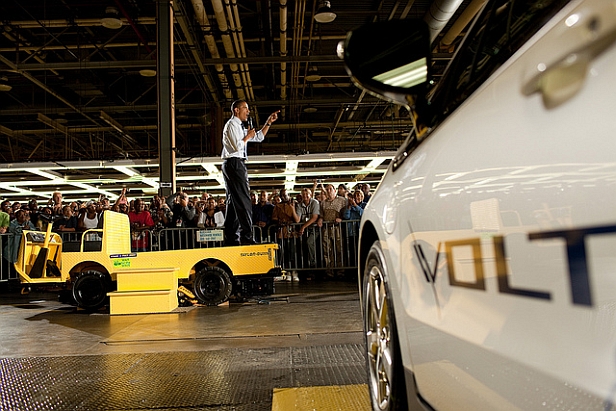If you read everything that bloggers declared a “must read,” you’d have time for little else. I’ll just say that if you want a lucid tour of the Obama administration’s work to remake the country’s energy and transportation landscape, it’s tough to beat Michael Grunwald’s new TIME piece “How the Stimulus is Changing America.”
Most coverage of the stimulus — the American Recovery and Reinvestment Act — looks at the “recovery” portion — the goal of saving and creating jobs. Grunwald looks into the 16 percent of funds marked for “reinvestment” — the long-term projects of confronting climate change, cutting oil addiction, building a 21st century economy (and also modernizing health care and education):
Yes, the stimulus has cut taxes for 95% of working Americans, bailed out every state, hustled record amounts of unemployment benefits and other aid to struggling families and funded more than 100,000 projects to upgrade roads, subways, schools, airports, military bases and much more. But in the words of Vice President Joe Biden, Obama’s effusive Recovery Act point man, “Now the fun stuff starts!” The “fun stuff,” about one-sixth of the total cost, is an all-out effort to exploit the crisis to make green energy, green building and green transportation real; launch green manufacturing industries; computerize a pen-and-paper health system; promote data-driven school reforms; and ramp up the research of the future. “This is a chance to do something big, man!” Biden said during a 90-minute interview with TIME.
For starters, the Recovery Act is the most ambitious energy legislation in history, converting the Energy Department into the world’s largest venture-capital fund. It’s pouring $90 billion into clean energy, including unprecedented investments in a smart grid; energy efficiency; electric cars; renewable power from the sun, wind and earth; cleaner coal; advanced biofuels; and factories to manufacture green stuff in the U.S. The act will also triple the number of smart electric meters in our homes, quadruple the number of hybrids in the federal auto fleet and finance far-out energy research through a new government incubator modeled after the Pentagon agency that fathered the Internet.
There’s very little in the story about who likes the $787 billion stimulus, who doesn’t, and how political consultants are using it in the midterm elections. Instead Grunwald reports on what the stimulus is actually doing (what a novel concept).
The $8 billion for high-speed passenger rail is the the boldest federal transportation initiative since the interstate highways, Grunwald notes. Investment in advanced batteries for electric cars will bring the number of U.S. factories from two to 30.
“Any one of those programs would have been a revolution in its own right,” he writes.
But should the government be picking winners and losers? I’ve harped enough lately about how that’s a bogus question unless you consider how the government already subsidizes winners in energy (oil and coal) and transporation (automobiles).
Grunwald takes a look the administration’s plan for keeping waste out of the stimulus:
Every contract and lobbying contact is posted at Recovery.gov, with quarterly data detailing where the money went. A Recovery Board was created to scrutinize every dollar, with help from every major agency’s independent watchdog. And Biden has promised state and local officials answers to all stimulus questions within 24 hours. It’s a test-drive for a new approach to government: more transparent, more focused on results than compliance, not just bigger but better. Biden himself always saw the Recovery Act as a test–not only of the new Administration but of federal spending itself. He knew high-profile screwups could be fatal, stoking antigovernment anger about bureaucrats and two-car funerals. So he spends hours checking in, buttering up and banging heads to keep the stimulus on track, harassing Cabinet secretaries, governors and mayors about unspent broadband funds, weatherization delays and fishy projects. He has blocked some 260 skate parks, picnic tables and highway beautifications that flunked his what-would-your-mom-think test. …
So far, despite furor over cash it supposedly funneled to contraception (deleted from the bill) and phantom congressional districts (simply typos), the earmark-free Recovery Act has produced surprisingly few scandals. Prosecutors are investigating a few fraud allegations, and critics have found some goofy expenditures, like $51,500 for water-safety-mascot costumes or a $50,000 arts grant to a kinky-film house. But those are minor warts, given that unprecedented scrutiny. Biden knows it’s early – “I ain’t saying mission accomplished!” – but he calls waste and fraud “the dogs that haven’t barked.”
The Recovery Act’s deeper reform has been its focus on intense competition for grants instead of everybody-wins formulas, forcing public officials to consider not only whether applicants have submitted the required traffic studies and small-business hiring plans but also whether their projects make sense. Already staffed by top technologists from MIT, Duke and Intel, ARPA-E [the administration’s in-house venture capital arm] recruited 4,500 outside experts to winnow 3,700 applications down to 37 first-round grants. “We’ve taken the best and brightest from the tech world and created a venture fund–except we’re looking for returns for the country,” Majumdar says. These change agents didn’t uproot their lives to fill out forms in triplicate and shovel money by formula. They want to reinvent the economy, not just stimulate it. Sadoway, the MIT battery scientist, is tired of reporting how many jobs he’s created in his lab: “If this works, I’ll create a million jobs!”
Jonathan Cohn at The New Republic adds a comment:
Skeptics may roll their eyes at this, but they shouldn’t. Mike, whom I know well, is a famously skeptical journalist who has won a slew of awards for his tough coverage of government agencies. (Just ask the Army Corps of Engineers.) If he is enthusiastic about the Recovery Act, then you should be, too.
For a skeptical but fair take, see Derek Thompson at The Atlantic, who asks “Why Wasn’t the Stimulus All About Job Creation?“


